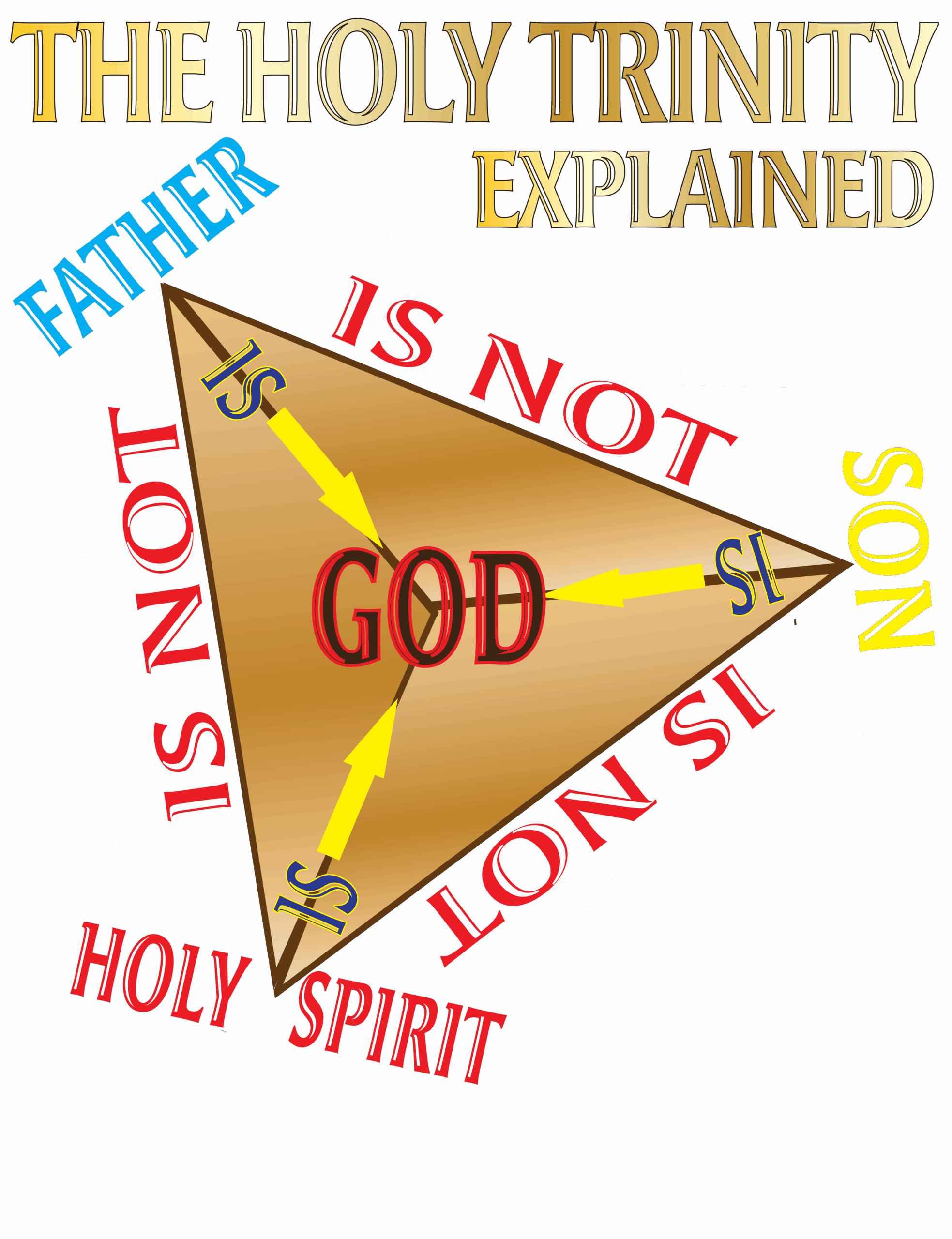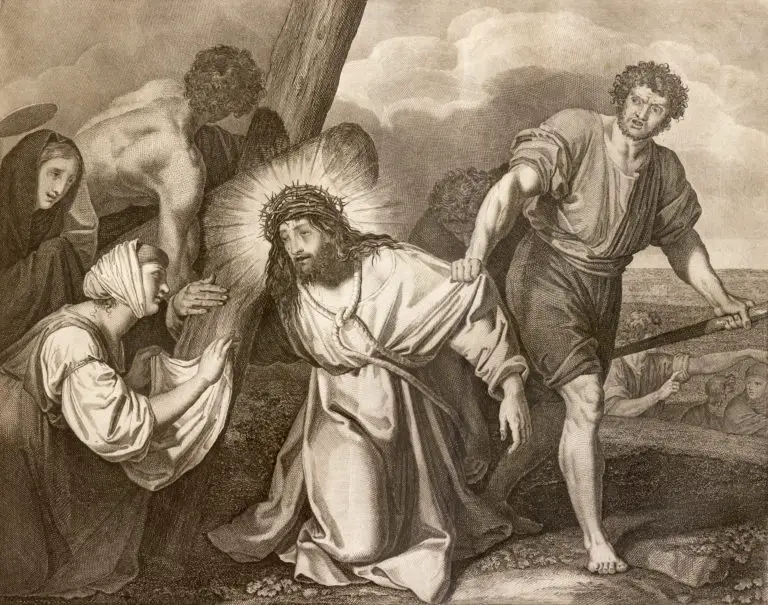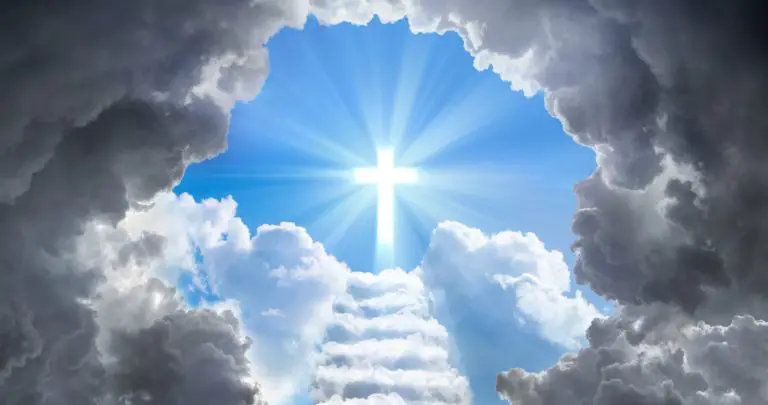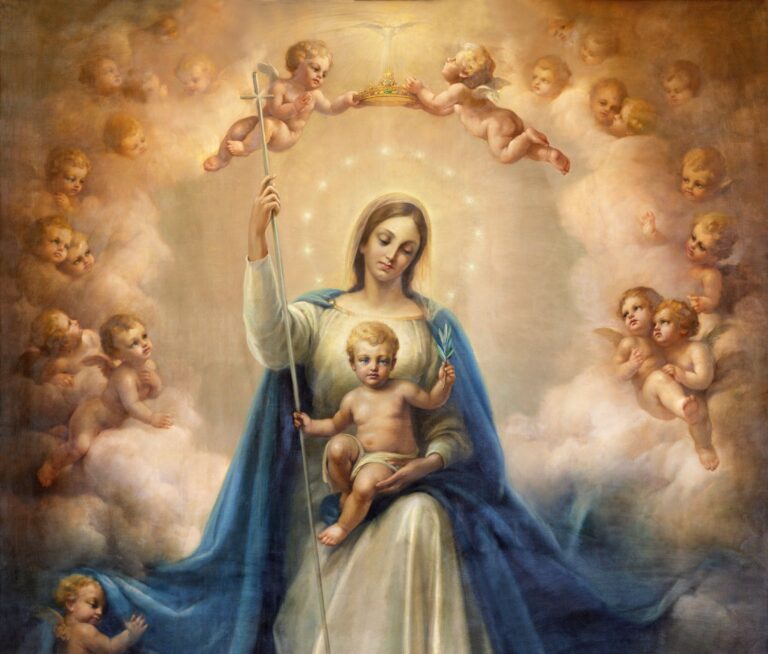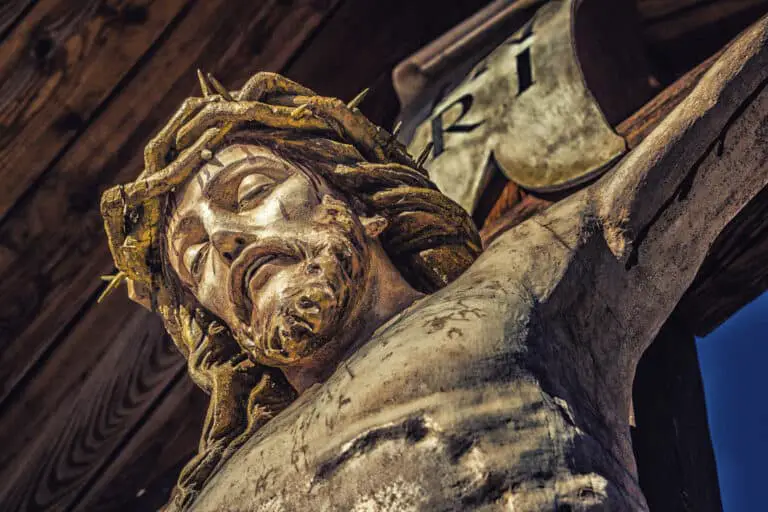How do we Understand the Trinity?
Did you know that the word “Trinity” never appears in the Holy Scriptures? This might come as a surprise to many Catholics and Christians alike. Yet, while the actual term is absent from the Bible, the concept of one God existing eternally as three distinct Persons is beautifully woven throughout the fabric of Scripture.
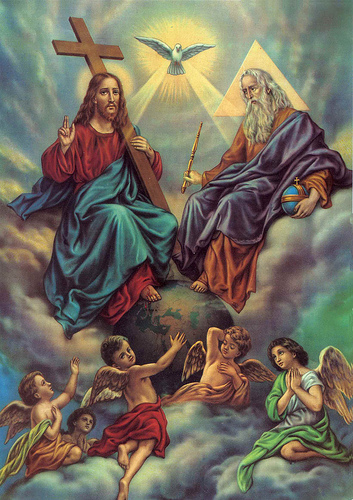
The Holy Trinity stands as the central mystery of our Catholic faith. Simply put, the term “Trinity” means “three-in-one,” revealing how God the Father, God the Son (Our Lord Jesus Christ), and God the Holy Spirit are three distinct Persons yet one divine Being. The understanding of this profound reality wasn’t formally articulated until the mid-2nd century by the early Church Fathers and later received clear definition at the First Council of Nicaea in 325 AD.
Throughout the history of the Church, the Trinity has challenged the minds of both ordinary believers and the most learned theologians. We find several Trinitarian expressions in the New Testament, most notably in Matthew 28:19, where Our Lord instructs His disciples to baptize “in the name of the Father, Son, and Holy Spirit.” What is fascinating is that the Holy Spirit is mentioned 275 times in the New Testament—nearly four times more frequently than in the Old Testament, showing the progressive revelation of God’s nature.
As Catholics, we believe in the mystery of the Trinity not because we can fully comprehend it, but because God has revealed it to us through Scripture and Tradition. In this exploration of God’s triune nature, I hope to guide you through this beautiful mystery without diminishing its profound depth. Whether you are new to the faith or seeking deeper understanding, let us contemplate together this most fundamental truth about who God is.
Recommended Reading:
The Catechism of the Catholic Church (sections 232-267 on the Trinity)
St. Augustine’s “De Trinitate” (On the Trinity)
St. Thomas Aquinas’ “Summa Theologica” (First Part, Questions 27-43)
Why the Trinity Is Difficult to Comprehend?
When discussing the Holy Trinity with fellow Catholics and those seeking to understand our faith, I often encounter the question: Why is this fundamental doctrine so challenging to grasp? The answer lies not in any deficiency of the doctrine itself, but rather in the limitations of our human intellect when confronted with divine reality.
1) The Infinite God and Our Finite Minds
The primary challenge in understanding the Trinity stems from the vast gulf between God’s infinite nature and our limited human comprehension.
As we read in Isaiah 55:8-9,
“For My thoughts are not your thoughts, neither are your ways My ways… As the heavens are higher than the earth, so are My ways higher than your ways and My thoughts than your thoughts” [3].
This Scripture beautifully illustrates the immense distance between divine wisdom and human understanding.
The holy man Job acknowledged this human limitation when he declared,
“Behold, these are but the fringes of His ways; how faint is the whisper we hear of Him! Who then can understand the thunder of His power?” [3]. His words capture a profound truth—we can only glimpse the edges of God’s reality.
Our human understanding faces several fundamental constraints when contemplating the divine:
Our imaginations are bound by what we experience through our senses [3]
We know God primarily through analogies to created things [3]
We tend to place God and nature on the same level, as if they compete as causes [3]
We struggle to comprehend anything outside time and space [3]
The Trinity is what the Church Fathers and theologians call “a mystery of faith in the strict sense”—a truth about God known only through divine revelation, not through reason or philosophy alone [4]. This doesn’t mean it contradicts reason, but rather transcends it. As St. Augustine wisely noted in his contemplations, “If you understood Him, it would not be God” [4].
2) The Role of Mystery in Our Faith
Many believe that mystery in our Catholic faith is a problem to be solved or eliminated. On the contrary, mystery is a reality to be embraced with reverence. The Catechism of the Catholic Church identifies the Trinity as “the central mystery of Christian faith and life” [5] and “the source of all other mysteries of faith” [4]. This is not a peripheral teaching—it is the very foundation of our belief.
The Trinity is mysterious not because it lacks meaning but because it is “saturated in meaning” [5]. Like trying to behold the vastness of the ocean or universe in a single glance, the Trinity contains too much truth to be comprehended all at once.
Accepting mystery doesn’t mean abandoning the pursuit of understanding. Rather, it means recognizing that faith and reason work together in harmony. As St. John Paul II beautifully expressed in his encyclical Fides et Ratio, “faith builds upon and perfects reason” [6]. Our faith acknowledges the limits of human understanding while continuing to seek deeper insight.
The mystery of the Holy Trinity serves several purposes in our spiritual life:
It humbles us, reminding us that God is infinitely greater than we are [7]
It prevents us from creating false images of God based on our limited understanding [8]
It teaches us that God’s inner nature is relational and loving [8]
It invites us into deeper contemplation rather than quick categorization
Even St. Paul, when contemplating God’s wisdom, exclaimed:
“Oh, the depth of the riches of the wisdom and knowledge of God! How unsearchable his judgments, and his paths beyond tracing out! Who has known the mind of the Lord? Or who has been his counselor?” [7].
His words capture both the awe and acceptance of divine mystery that should characterize our approach.
The proper response to the Trinity isn’t frustration but wonder and worship. Unlike human inventions, which we can fully grasp, the Trinity reflects a reality beyond our complete comprehension precisely because it reveals who God truly is.
What Is the Holy Trinity?
The Doctrine of the Holy Trinity stands as the most distinctive belief in our Catholic faith, setting it apart from other monotheistic religions. This foundational truth has shaped our understanding of God’s nature since the earliest days of the Church, though its formal articulation developed gradually over centuries through the guidance of the Holy Spirit.
A) One God in Three Divine Persons
The Holy Trinity is the truth that there exists one God who eternally exists as three distinct Persons: God the Father, God the Son, and God the Holy Spirit. These three are one God, co-equal and co-eternal, possessing precisely the same divine nature and attributes, and deserving of exactly the same worship, confidence, and obedience [9]. When we speak of the Trinity as Catholics, we profess that:
The following diagram illustrates this mystery:
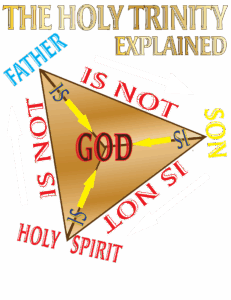
The Father is God, the Son is God, and the Holy Spirit is God
Yet they are not three gods but only one God
Each Person is distinct from the others (the Father is not the Son, the Son is not the Holy Spirit, etc.)
Each Person is fully divine individually, yet together they form the one true God
This profound mystery preserves both the oneness of God (monotheism) and the distinct personhood of Father, Son, and Holy Spirit. As St. Basil of Caesarea beautifully explained in the 370s AD,
“We confess one essence or substance so as not to give a variant definition of existence, but we confess a particular hypostasis, in order that our conception of Father, Son and Holy Spirit may be without confusion and clear” [10].
B) The Meaning of ‘Person’ and ‘Being’
To understand the Trinity, we must clarify what theologians mean by “person” and “being” (or essence). First, it is crucial to note that when referring to divine Persons, we are not speaking of human individuals. The term “person” in Trinitarian theology does not signify an independent individual as we commonly understand personhood today [11].
Rather, a divine Person is a distinct subject with a center of consciousness that regards Himself as “I” while regarding the others as “You” [11]. Each Person possesses intellect, emotion, and will [12]. The Father speaks to the Son, the Son prays to the Father, and both send the Spirit—showing real relationship between distinct persons.
“Being” or “essence,” meanwhile, refers to what God is—His divine nature or substance. The three Persons share one undivided divine essence. As theologians explain, “The divine essence is not something that is divided between the three persons, but is fully in all three persons without being divided into ‘parts'” [11]. Therefore, the Son is not one-third of God; He is fully God. The same applies to the Father and Holy Spirit.
C) Is the Word ‘Trinity’ in the Bible?
The word “Trinity” never appears in Scripture [9]. Neither does “Triune God” or similar terminology. The term comes from Latin Trinitas, which combines unitas (“unity”) and trias (“three”) [14]. Tertullian, writing around AD 213, is generally recognized as the first to apply this term to God [15].
Nevertheless, the absence of the word does not invalidate the concept. As St. Augustine explained, we believe in the Trinity not because of the word itself but because of what the Bible teaches [14]. Similarly, other theological terms like “inerrancy” are not found in Scripture, yet their concepts are firmly biblical [9].
Throughout the Holy Scriptures, we find numerous passages that, taken together, establish the doctrine of the Trinity:
The Bible affirms there is only one God (Deuteronomy 6:4; 1 Corinthians 8:4)
Scripture attributes full deity to the Father, Son, and Holy Spirit
The Bible distinguishes between the three Persons (at Our Lord’s baptism, all three appear simultaneously—Matthew 3:16-17)
The doctrine developed formally through Church councils as the faithful sought to articulate their understanding of God’s nature revealed in Scripture. The Council of Nicaea (325 AD) and the Council of Constantinople (381 AD) were particularly significant in establishing the full divinity of both the Son and Holy Spirit [16].
Though the term itself is post-biblical, the Trinity concept represents the Church’s faithful attempt to understand and articulate the fullness of God’s self-revelation—one God existing eternally as Father, Son, and Holy Spirit.
I highly recommend studying the Catechism of the Catholic Church (paragraphs 232-267) for a deeper understanding of this essential doctrine. The writings of the Church Fathers, especially St. Augustine’s “De Trinitate,” provide profound insights into this mystery that lies at the heart of our faith.
How does Scripture gradually reveal the The Trinity?
Throughout the Holy Scriptures, God gradually reveals His triune nature to humanity. The revelation of the Trinity unfolds progressively, like many divine mysteries, becoming clearer as salvation history advances. Let us explore how both the Old and New Testaments present this profound truth of our faith.
A) Hints in the Old Testament
The Old Testament contains several subtle indications of God’s triune nature, though not explicitly stating the doctrine. As Catholics, we recognize these early glimpses that prepared God’s people for the fuller revelation to come.
First, we see instances where God refers to Himself using plural pronouns:
“Let us make man in our image” (Genesis 1:26),
“The man has now become like one of us” (Genesis 3:22), and “Come, let us go down and confuse their language” (Genesis 11:7).
These plural forms suggest a divine conversation within God Himself.
Second, the mysterious “Angel of the Lord” appears throughout the Old Testament, sometimes speaking as God while also being distinguished from God. In Genesis 16:10, this Angel tells Hagar,
“I will increase your descendants,” claiming divine authority. Similarly, in Genesis 22:12, He tells Abraham,
“You have not withheld from me your son,” identifying Himself with God. Many Church Fathers saw in this Angel a pre-incarnate appearance of the Second Person of the Trinity.
Third, the Old Testament speaks of God’s Spirit as seemingly distinct from God Himself. In Nehemiah 9:20, we read,
“You also gave Your good Spirit to instruct them,” and Isaiah 48:16 states,
“And now the Lord GOD has sent Me, and His Spirit,”
suggesting three distinct Persons.
It is worth noting that even the Hebrew name for God, Elohim, carries a plural form while taking singular verbs, perhaps hinting at unity within plurality. St. Augustine and other Church Fathers saw in this grammatical peculiarity an early indication of the Trinity.
B) Fuller Revelation in the New Testament
The New Testament brings the Trinity into much clearer focus. I find the Baptism of Jesus to be perhaps the most vivid manifestation:
“Jesus came up immediately from the water; and behold, the heavens were opened, and he saw the Spirit of God descending as a dove and lighting on Him, and a voice from heaven said, ‘This is my beloved Son, in whom I am well pleased'”
(Matthew 3:16-17).
Here, all three Persons of the Trinity are simultaneously present and distinct.
Our Lord Himself spoke frequently about His relationship with the Father and the Holy Spirit. In John 14:26, He promises,
“The Helper, the Holy Spirit, whom the Father will send in My name, He will teach you all things.”
This statement clearly distinguishes the three Persons while showing their perfect unity of purpose.
The most explicit Trinitarian formula appears in Christ’s Great Commission:
“Go therefore and make disciples of all nations, baptizing them in the name of the Father and of the Son and of the Holy Spirit” (Matthew 28:19).
Notice that Our Lord says “name” (singular), not “names,” indicating one divine nature shared by three Persons.
C) Key Passages Revealing the Trinity
Several passages in Sacred Scripture reference all three Persons of the Holy Trinity together:
2 Corinthians 13:14 – “The grace of the Lord Jesus Christ and the love of God and the fellowship of the Holy Spirit be with you all.” This apostolic benediction naturally includes all three Persons.
Ephesians 2:18 – “For through Him [Jesus] we both have our access in one Spirit to the Father.”
1 Peter 1:2 – “According to the foreknowledge of God the Father, by the sanctifying work of the Spirit, to obey Jesus Christ and be sprinkled with His blood.”
John 15:26 – “When the Helper comes, whom I will send to you from the Father, that is the Spirit of truth who proceeds from the Father, He will testify about Me.”
Moreover, the New Testament clearly establishes that:
The Father is God (John 6:27; Romans 1:7)
Jesus Christ is God (John 1:1, 14; Colossians 2:9)
The Holy Spirit is God (Acts 5:3-4; 1 Corinthians 3:16)
While Sacred Scripture never uses the word “Trinity,” the evidence for one God existing as three divine Persons emerges unmistakably when we examine the Bible as a whole. The Old Testament provides the foundation through subtle hints, while the New Testament brings this truth into magnificent light.
How to teach the Mystery of the Holy Trinity?
Teaching others about the Holy Trinity need not be a daunting task. Despite its profound theological depth, this central doctrine of our Catholic faith can be explained with clarity when approached with reverence and humility.
1) Begin with the Essential Truth
When explaining the Trinity to someone unfamiliar with this doctrine, I highly recommend starting with a clear, straightforward definition:
“The Holy Trinity is the foundational Catholic belief that God is one divine Being who eternally exists as three distinct Persons—Father, Son, and Holy Spirit.”
This simple definition establishes both the unity of God’s divine nature and the distinction of the three divine Persons. The Catechism of the Catholic Church beautifully expresses this mystery as “one God in three Persons” (CCC 253).
To clarify further, we must understand these key terms:
Being or Nature = WHAT God is (divine essence)
Person = WHO each is within the Godhead (Father, Son, Holy Spirit)
For instance, just as I am human by nature but a unique individual by person, God is divine in nature while existing as Father, Son, and Holy Spirit in Person. However, this analogy has significant limitations, as I possess only one person while God is three Persons in perfect unity.
2) Use Sacred Language with Clarity
When discussing the Holy Trinity, we must be careful to use language that honors the sacred mystery while remaining accessible. The Church Fathers wrestled with explaining these truths, and we can learn much from their approach.
First, avoid overwhelming beginners with specialized theological terms like “consubstantial,” “hypostasis,” or “procession” without explanation. These have their proper place in formal theology, but for those new to the faith, simpler expressions often better convey the same eternal truths.
Second, focus on the relational aspects of the Trinity that we can somewhat grasp through our own experience of love and relationship. The Father eternally loves the Son, the Son perfectly obeys the Father, and the Holy Spirit proceeds from both—a divine communion of perfect love that has existed for all eternity.
Let us consider that the early Church used the Nicene Creed to teach ordinary believers about the Trinity. This ancient profession of faith describes each divine Person with beautiful clarity:
God the Father as “maker of heaven and earth”
Jesus Christ as “begotten, not made, consubstantial with the Father”
The Holy Spirit as “the Lord, the giver of life”
3) Embrace the Sacred Mystery
The most common mistake when explaining the Holy Trinity is attempting to resolve every aspect of this divine mystery. As St. Augustine wisely noted after writing extensively on the Trinity, “If you understand it, it is not God.”
When teaching others about this central doctrine, I would not do it any justice by suggesting it can be fully comprehended. Instead, focus on these core truths revealed in Scripture and upheld by the Church:
There is only one true God
The Father, Son, and Holy Spirit are each fully God
The three divine Persons are truly distinct from one another
Beyond these essential points, we must be comfortable acknowledging the limits of human understanding. Such humility honors both God’s transcendent nature and our finite minds.
Remember that faith seeks understanding gradually. The goal is not complete comprehension in a single conversation but planting seeds of truth that can flourish through prayer, Scripture study, and the guidance of the Holy Spirit.
Recommended Resources for Understanding the Trinity:
The Catechism of the Catholic Church (sections 232-267)
“The Trinity” by St. Augustine
“Mere Christianity” (Book 4) by C.S. Lewis
“The One Thing Is Three” by Fr. Michael Gaitley
What are some Common Analogies for the Holy Trinity (and Why They Fall Short)?
Throughout the centuries, Catholics and other Christians have developed various analogies to help explain the mystery of the Holy Trinity. These comparisons seek to make this profound doctrine more accessible, particularly for those new to the faith or for children learning their catechism. Yet, as with all human attempts to describe the divine nature of God, these illustrations have significant limitations that we must acknowledge.
I) Water: Liquid, Ice, and Steam
One of the most commonly used Trinity analogies compares God to water, which exists in three different states—liquid water, solid ice, and gaseous steam. This illustration shows how all three forms share the same chemical composition (H₂O) while appearing and behaving differently.
The problem with this analogy is that it unintentionally leads toward the heresy of modalism. Water cannot simultaneously exist as liquid, solid, and gas in the same location and under the same conditions. It changes from one form to another. In contrast, the Father, Son, and Holy Spirit coexist eternally as distinct Persons. The Father does not “become” the Son or the Holy Spirit as water changes states. This was condemned by the early Church as the heresy of Sabellianism.
II) Egg: Shell, White, and Yolk
Another popular comparison presents the Trinity as similar to an egg with its three components—shell, white, and yolk—comprising one complete egg. This simple illustration appears straightforward and is often taught to children.
Unfortunately, this analogy inadvertently promotes partialism—another theological error. The shell, white, and yolk are merely parts of an egg, with each representing only a portion of the whole. By contrast, each Person of the Trinity is fully God, not just a “part” of God. As the Athanasian Creed affirms, we worship “neither confounding the Persons nor dividing the Substance.”
III) Sun: Star, Light, and Heat
St. John of Damascus, one of the great Doctors of the Church, compared the Trinity to the sun (Father), its light rays (Son), and its heat (Holy Spirit). This analogy beautifully shows how each element proceeds from a source while remaining connected.
However, even this illustration from a great Church Father can suggest Arianism if not properly explained. Arianism, condemned at the Council of Nicaea in 325 AD, claimed that the Son and Spirit are mere creations of the Father. Just as light and heat are natural byproducts of the sun, this might imply the Son and Spirit are subordinate to or less divine than the Father, which contradicts the doctrine of the Trinity.
Why do All Analogies Fall Short?
The Catechism of the Catholic Church reminds us that “The Trinity is a mystery of faith in the strict sense, one of the mysteries that are hidden in God, which can never be known unless they are revealed by God” (CCC 237).
All Trinity analogies ultimately fail because they attempt to compare the uncreated Creator with created things. The Trinity, being unique and divine, inherently transcends complete comparison with anything in the natural world. St. Augustine spent over 15 years writing his treatise “De Trinitate” and still acknowledged the inadequacy of human language to fully capture this mystery.
Most analogies either:
Divide God’s essence (partialism)
Confuse the Persons (modalism)
Suggest inequality within the Trinity (Arianism)
Rather than seeking perfect explanations, we should approach these comparisons with humility, using them cautiously as starting points while acknowledging their limitations. The mystery of the Trinity calls us not to complete understanding but to reverent adoration of the God who has revealed Himself to us as Father, Son, and Holy Spirit.
How the Trinity Affects Our Daily Catholic Life?
The Holy Trinity is not merely an abstract theological concept to be studied, but rather a living reality that profoundly shapes our Catholic life and spirituality. Understanding God as Father, Son, and Holy Spirit transforms how we approach prayer, comprehend the mysteries of salvation, and experience relationship with our Creator and with one another.
I) The Trinity in Prayer and Worship
The Trinitarian nature of God establishes the pattern for our Catholic prayer and worship. Throughout the Church’s history, we have typically prayed to the Father, through the Son, by the power of the Holy Spirit [11]. This reflects the natural flow of divine communication where all three Divine Persons work in perfect harmony yet maintain their distinct roles.
When we pray, we may address each Person individually while recognizing their essential unity. St. Paul demonstrates this beautifully in 2 Corinthians 13:14, offering a benediction that honors all three Persons:
“The grace of the Lord Jesus Christ, and the love of God, and the fellowship of the Holy Spirit be with you all” [17].
The Holy Trinity prevents an imbalanced spirituality that might elevate one Person above the others. Our Catholic worship must acknowledge all three Persons to be complete and authentic [18]. This is why we begin and end our prayers with the Sign of the Cross, invoking the Trinity as we touch our forehead, chest, and shoulders.
II) The Trinity and Our Salvation
The mystery of salvation unfolds through the cooperative work of the Trinity:
God the Father initiates our salvation through His eternal plan and predestination [19]
God the Son accomplishes our salvation through His Incarnation and redemptive sacrifice on the Cross [19]
God the Holy Spirit applies salvation through sanctification and the gift of faith [19]
Therefore, the Gospel message itself is intrinsically Trinitarian [20]. Each Divine Person plays a vital role, perfectly unified in purpose yet distinct in function. As Catholics, we recognize this Trinitarian pattern in the sacraments, especially in Baptism, where we are baptized “in the name of the Father, and of the Son, and of the Holy Spirit.”
III) Living in Trinitarian Relationship
Perhaps most significantly, the Holy Trinity provides the perfect model for human relationships. St. John Paul II often emphasized that being created in God’s image means we are created for communion, just as God Himself exists as a communion of Persons.
The Trinity reveals that God’s very nature is relational. Consequently, we humans—created in God’s image—are designed for relationship [21]. We find our true identity not in isolation but in community, mirroring the eternal fellowship within the Godhead. This is profoundly expressed in the life of the Church, the family, and all human communities.
Additionally, the Trinity teaches us the virtues of humility, love, worship, submission, and joy [22]. These qualities flow naturally from understanding that relationship lies at the heart of reality itself. The mutual love and self-giving of Father, Son, and Holy Spirit become the model for our own relationships.
A great practice is to recite the Glory Be (Gloria Patri) mindfully throughout your day, giving honor to all three Divine Persons:
“Glory be to the Father, and to the Son, and to the Holy Spirit, as it was in the beginning, is now, and ever shall be, world without end. Amen.”
The Living Mystery of the Holy Trinity in Our Catholic Faith
Throughout our exploration of the Holy Trinity, we have contemplated one of the most profound mysteries of our Catholic faith. Though this divine reality exceeds our complete understanding, it remains not peripheral but absolutely central to our belief as Catholics. The Trinity is not merely a theological concept to be studied but a living reality that shapes our prayer, worship, and daily Christian journey.
As we have seen, human analogies—whether water, egg, or sun—ultimately fall short when attempting to capture the infinite nature of God. Yet this should not discourage us from seeking deeper understanding. Rather, it should inspire humble reverence before the mystery of who God is. The Holy Trinity reveals that God Himself is a communion of Persons, showing us that love and relationship exist within the very essence of the Divine Being.
Our finite minds cannot fully comprehend how one God exists eternally as Father, Son, and Holy Spirit. This limitation, however, draws us toward wonder rather than frustration. St. Augustine wisely remarked that if we could fully understand God, He would not be God at all. The mystery of the Trinity invites us not merely to intellectual assent but to personal relationship with this Triune God who has revealed Himself to us through Scripture and Tradition.
We should take comfort in knowing that the great Saints and Church Fathers before us—from St. Augustine to St. Thomas Aquinas to St. Teresa of Avila—all wrestled with this doctrine. Their faithful contemplation has deepened the Church’s understanding while preserving the beautiful mystery at its core. Let us approach the Trinity with both intellectual curiosity and profound humility, recognizing that this doctrine ultimately points to the God who created us, redeemed us, and sanctifies us—three Persons, one God, perfect in unity and love.
May the grace of Our Lord Jesus Christ, the love of God the Father, and the communion of the Holy Spirit remain with you always as you continue to contemplate this most sacred mystery of our faith.
Recommended Resources:
The Catechism of the Catholic Church (sections 232-267)
“The One Thing is Three” by Fr. Michael Gaitley
“Theology for Beginners” by Frank Sheed
FAQs
Q1. How can we simply explain the Trinity? The Trinity is the Christian belief that there is one God who eternally exists as three distinct Persons – the Father, the Son, and the Holy Spirit. Each Person is fully God, equal in power and glory, yet there is only one God, not three gods. While challenging to fully comprehend, this doctrine reveals God’s relational nature.
Q2. Why is the Trinity difficult to understand? The Trinity is difficult to understand because it involves finite human minds trying to grasp an infinite, divine reality. God’s triune nature transcends complete human comprehension, as there is no perfect analogy in the created world to fully explain how one Being can exist as three distinct Persons. This mystery invites wonder rather than frustration.
Q3. How does the Trinity affect Christian life? The Trinity profoundly shapes Christian life by providing a framework for prayer and worship, deepening our understanding of salvation, and modeling perfect relationship. Christians typically pray to the Father, through the Son, by the power of the Holy Spirit. The Trinity also reveals that God’s very nature is relational, inspiring believers to live in holy community.
Q4. Are there any helpful analogies to explain the Trinity? While no analogy is perfect, some find it helpful to compare the Trinity to water existing as liquid, ice, and steam; or to the sun with its star, light, and heat. However, all analogies fall short and can unintentionally promote misunderstandings if overextended. It’s important to recognize their limitations when using them to explain the Trinity.
Q5. Is the word “Trinity” found in the Bible? The word “Trinity” does not appear in the Bible. It was first used by the early church father Tertullian around 200 AD to describe the biblical teaching of one God existing in three Persons. While the term itself is not found in Scripture, the concept is derived from the Bible’s overall portrayal of God’s nature and interactions with humanity.
References
[1] – https://biblehub.com/topical/l/limitations_of_human_understanding.htm
[2] – https://biblehub.com/topical/h/human_limitations_in_understanding_god.htm
[3] – https://catholicscientists.org/articles/god-science-and-the-limits-of-human-imagination/
[4] – https://www.catholicworldreport.com/2022/06/11/the-trinity-a-mystery-for-eternity-2/
[5] – https://fatherzack.com/f/the-trinity-the-central-mystery-of-christian-faith-life
[6] – http://ignatius.edu/news/june-2020/the-mystery-of-the-trinity
[7] – https://www.gotquestions.org/Trinity-Bible.html
[8] – https://www.denvercatholic.org/love-revealed-understanding-the-central-mystery-of-the-trinity
[9] – https://www.christianity.com/wiki/god/god-in-three-persons-a-doctrine-we-barely-understand-11634405.html
[10] – https://www.thegospelcoalition.org/blogs/justin-taylor/what-do-we-mean-by-person-and-essence-in-the-doctrine-of-the-trinity/
[11] – https://www.cru.org/us/en/train-and-grow/spiritual-growth/core-christian-beliefs/understanding-the-trinity.html
[12] – https://www.gotquestions.org/God-in-three-persons.html
[13] – https://plato.stanford.edu/entries/trinity/
[14] – https://biblemesh.com/blog/why-do-we-use-the-word-trinity-when-it-doesnt-show-up-in-the-bible/
[15] – https://www.gotquestions.org/origin-doctrine-Trinity.html
[16] – https://www.britannica.com/topic/Trinity-Christianity
[17] – https://www.blueletterbible.org/Comm/stewart_don/faq/the-trinity/03-how-does-the-doctrine-of-the-trinity-affect-the-christian-life.cfm
[18] – https://www.modernreformation.org/resources/articles/trinity-and-christian-life
[19] – https://learn.ligonier.org/articles/trinity-works-together-salvation
[20] – https://www.youthpastortheologian.com/blog/is-the-trinity-essential-for-salvation
[21] – https://www.cathedralatl.org/sermons/holy-trinity-is-holy-relationship/
[22] – https://realfaith.com/what-christians-believe/what-are-the-practical-implications-of-the-trinity/
